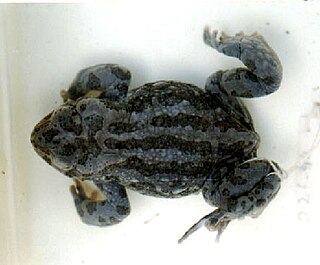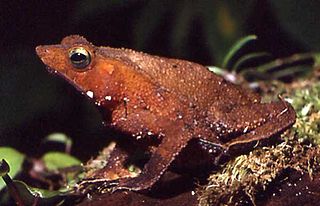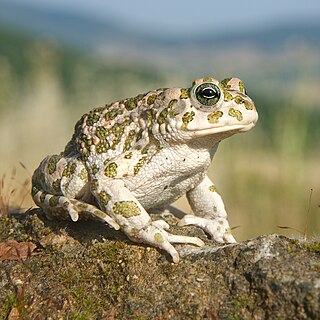
The natterjack toad is a toad native to sandy and heathland areas of Europe. Adults are 60–70 mm in length, and are distinguished from common toads by a yellow line down the middle of the back, and parallel paratoid glands. They have relatively short legs, which gives them a distinctive gait, contrasting with the hopping movement of many other toad species.

A true toad is any member of the family Bufonidae, in the order Anura. This is the only family of anurans in which all members are known as toads, although some may be called frogs. The bufonids now comprise more than 35 genera, Bufo being the best known.

The Mongolian toad, also known commonly as the piebald toad or the Siberian sand toad, is a species of toad in the family Bufonidae. The species is endemic to northeastern Asia. It was formerly placed in the genus Bufo, then for a few years in Pseudepidalea until finally moved to its own genus Strauchbufo.

The Dhofar toad or Oman toad, Duttaphrynus dhufarensis, is a species of toad in the family Bufonidae. It is endemic to the Arabian Peninsula and is found in Oman, Saudi Arabia, the United Arab Emirates, and Yemen.
The Nile Delta toad or Damietta toad is a species of toad in the family Bufonidae. It is endemic to Egypt, where it is found from the Nile Delta to as far south as Luxor. Its natural habitats are swamps, freshwater marshes, arable land, urban areas, seasonally flooded agricultural land and canals and ditches.

Xanthophryne koynayensis is a species of toad in the family Bufonidae. It is endemic to the Western Ghats of India where it is known from Koyna in the Maharashtra state. Formerly included in the genus Bufo it has been since made the type species for the genus Xanthophryne and is a sister species of Xanthophryne tigerina.
Sclerophrys langanoensis is a species of toad in the family Bufonidae. It is endemic to northern Rift Valley in Ethiopia, where it has been recorded from Lake Langano and the Awash National Park; the latter population might represent a distinct species. It is likely that this species will also be found in Eritrea and Somalia. Common name Lake Langano toad has been coined for it.

Bufotes latastii, commonly known as the Baltistan toad, Ladakh toad or vertebral-banded toad, is a species of toad in the family Bufonidae. It is found in the West Himalayan region at altitudes of 780–3,200 m (2,560–10,500 ft) from northern Pakistan to Ladakh in India; although sometimes reported elsewhere, this is the result of misidentifications of other species. It is found in alpine forests, coniferous forests, grasslands, paddy fields, mountain desert and roadsides. It often lives near water, like lakes and ponds, in the riparian growth. It can be beneficial to humans as it feeds on insects and their larvae within areas of agriculture.

Incilius luetkenii is a species of toad in the family Bufonidae. It is found in the Mesoamerica along the Pacific versant from central Costa Rica to extreme southern Chiapas, Mexico, as well as dry interior valleys of Guatemala and Honduras and San Juan River drainage in Costa Rica on the Atlantic versant. It occurs in open areas, including disturbed pasturelands in lowland dry forest, and to a lesser extent, in lowland moist and premontane moist forests. It breeds in temporary pools. It is a common species that is not facing major threats.

Bufotes luristanicus, the Lorestan earless toad or Lorestan toad, is a species of toad in the family Bufonidae. It is endemic to the Zagros Mountains in Iran and occurs at an altitude of 350–1,300 m (1,150–4,270 ft), most often near rocky outcrops or freshwater ponds, which it also uses for breeding. Little is known about this species, but it is not considered threatened overall. Some local populations may be threatened by habitat loss from human activities or drought.
Mertensophryne mocquardi is a species of toad in the family Bufonidae. It is endemic to Kenya and known from Mount Kenya, the Kinangop Plateau, and the highlands surrounding Nairobi. The specific name mocquardi refers to François Mocquard, a French herpetologist. It was put in synonymy of Mertensophryne lonnbergi in 1972, but re-validated in 1997.

Rhinella proboscidea is a species of small South American toad in the family Bufonidae, common in the Amazon rainforest. It is the only species known to practice reproductive necrophilia.
Bufotes pseudoraddei is a species of toad in the family Bufonidae. It is found in the West Himalayan region, including northern Pakistan and the border area between western Xizang of China and adjacent northwestern India. Its natural habitats are temperate forests, intermittent freshwater marshes, arable land, pastureland, plantations, and rural gardens.

Duttaphrynus scaber is a species of toad in the family Bufonidae. It is found in peninsular India and Sri Lanka. Bufo fergusonii, now synonymized with Duttaphrynus scaber, was named after Harold S. Ferguson who collected the type specimen.

The Japanese stream toad, also known as the Honshū Toad, is a species of toad in the family Bufonidae. It was first described by Masafumi Matsui in 1976 during research with Kyoto University as a "moderate to large-sized toad" with a "peculiar color pattern" and "stream-dwelling habits."
Sclerophrys vittata, also known as Degen's toad, banded toad, or Lake Victoria toad, is a species of toad in the family Bufonidae. It is endemic to Uganda, where it is only known from Lira south to Entebbe and the Bwindi Impenetrable Forest. This species may possibly be found in Kenya and its range may even extend into Egypt, but the records from northern Egypt are generally regarded as belonging to S. kassasii.

The Balearic green toad is a toad belonging to the true toad family, Bufonidae, from Italy and islands in the western Mediterranean Sea. It is mostly a lowland species, but can be found as high as 1,300 m (4,300 ft) asl in central Italy.

Bufotes, the Eurasian green toads or Palearctic green toads, is a genus of true toads. They are native to Europe, western and central Asia and northern Africa; a region roughly equalling the western and central Palearctic. Historically they were included in the genus Bufo and then for a few years placed in Pseudepidalea, which is a synonym of the currently accepted name Bufotes.













